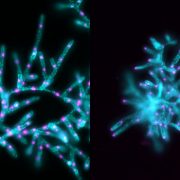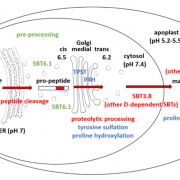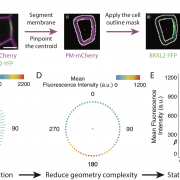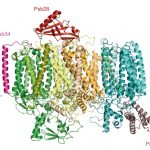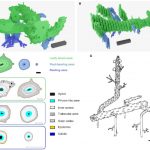Trapped in traffic – redefining cellular responses to auxin pharmacology (Plant Physiol.)
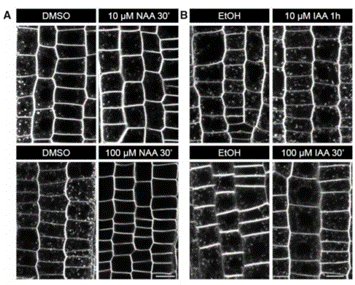 Understanding cellular responses to the phytohormone auxin has always been a challenge and decades of work has constantly renewed our knowledge of the same. Here, Narasimhan and colleagues attempted to revisit and resolve the basis of differential action of naturally occurring auxin indole-3-acetic acid (IAA) and its synthetic analogue naphthalene acetic acid (NAA) in mediating intracellular trafficking processes. Replicating classical experiments to understand the mechanism of auxin inhibition of the action of fungal toxin Brefeldin-A (BFA), they found both IAA and NAA to non-specifically inhibit formation of the endosomal aggregations. However, only NAA interfered in the endocytic recycling of proteins by modifying the lipid profile, and by effect the structure, of the endomembrane system. Interestingly, NAA and IAA acted alike to promote the specific, clathrin-mediated endocytosis of auxin efflux carrier PIN2, which the authors found to be necessary for its polar localization. Together, this study highlights the need to employ non-BFA based experiments to infer auxin effect on endocytosis and builds the foundation to better understand cellular events influenced by the pharmacological application of auxin analogues. (Summary by Pavithran Narayanan @pavi_narayanan) Plant Physiol. 10.1093/plphys/kiab134. Note: The implications of these findings are far-ranging and discussed in three accompanying commentaries that can be found here, here and here.
Understanding cellular responses to the phytohormone auxin has always been a challenge and decades of work has constantly renewed our knowledge of the same. Here, Narasimhan and colleagues attempted to revisit and resolve the basis of differential action of naturally occurring auxin indole-3-acetic acid (IAA) and its synthetic analogue naphthalene acetic acid (NAA) in mediating intracellular trafficking processes. Replicating classical experiments to understand the mechanism of auxin inhibition of the action of fungal toxin Brefeldin-A (BFA), they found both IAA and NAA to non-specifically inhibit formation of the endosomal aggregations. However, only NAA interfered in the endocytic recycling of proteins by modifying the lipid profile, and by effect the structure, of the endomembrane system. Interestingly, NAA and IAA acted alike to promote the specific, clathrin-mediated endocytosis of auxin efflux carrier PIN2, which the authors found to be necessary for its polar localization. Together, this study highlights the need to employ non-BFA based experiments to infer auxin effect on endocytosis and builds the foundation to better understand cellular events influenced by the pharmacological application of auxin analogues. (Summary by Pavithran Narayanan @pavi_narayanan) Plant Physiol. 10.1093/plphys/kiab134. Note: The implications of these findings are far-ranging and discussed in three accompanying commentaries that can be found here, here and here.


